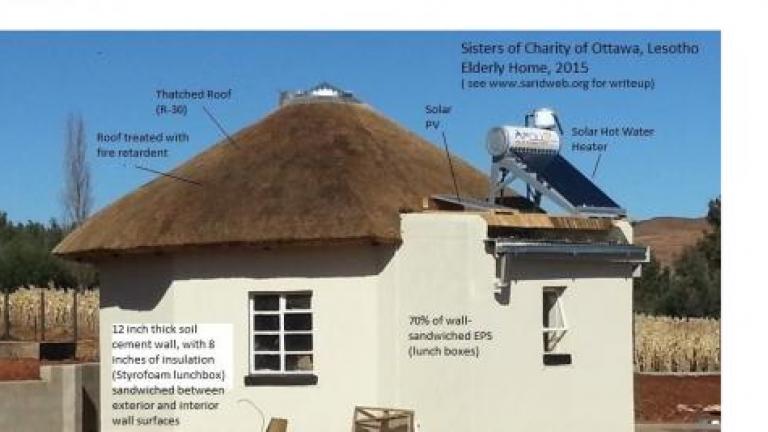
How can we build sustainable, naturally heated homes in poorer and colder regions of the world?
Javed Sultan, winner of the 2018 “Buildings” and “Adaptations” Climate CoLab contests, has designed a sustainable housing project with prototypes for low carbon, energy efficient homes. The project also has several social benefits, including employing local workers and providing housing. When asked about the inspiration behind this project, Javed comments: “Before coming to USA in 1980, I had been raised in and worked in several developing countries, and had often wondered if there was a more affordable way to build high performance buildings in poorer countries. After doing my graduate studies at MIT in architecture and civil engineering, I felt emboldened to experiment with some new building types - technologies.”
Javed’s proposal focuses on Lesotho, a country with warm summers and freezing winters. In 2015, Javed designed an energy efficient demonstration home for the elderly that was heated using renewable energy sources. The project also has several social benefits, including recycling waste, employing local workers, and providing housing. The house was built by students and local villagers, who received construction training throughout the process. Only 10% of the house's energy comes from fossil fuels; solar power heats and runs the home. The cost of the house, in spite of the added benefits, is 50% less, over an assumed 30 year life cycle, compared to known and currently practiced building technologies. The house would cost significantly less over an expected life of 70 to 80 years.

There are shared components that are essential to all of the homes Javed designs. First of all, people can be trained to build them within a couple of weeks. The building specifications require the structures to be energy efficient and affordable. Second, the houses need to be insulated, and have thermal mass to retain and slowly warm the home during freezing winters. Third, the source of heat for all of the houses cannot be fossil-fuel based, with a number of his designs using renewable energy sources such as solar hot water, and solar Photo Voltaic (PV) for low wattage LED lighting. The lighting fixtures last for 10 years before requiring to be replaced. Javed also ensures that the floors and walls have a thermal mass, incorporate recycled waste for insulation, and that the roof system can harvest rainwater. He is working on a ceramic filtering system to be incorporated in future homes that will purify the rain so it becomes potable by using locally manufactured affordable ceramic filters. The ceramic filters being tested are able to filter close to 99% of bacterial contaminants.

Javed states: “There is a widespread need for our building types. The building sector needs new building technologies and processes to deal with effects of climate change and ways to reduce and reverse global warming. We are offering a technology and process that will increase affordability while reducing greenhouse gas emissions.” Unless there is a technological intervention – people will not be able to afford “Green” buildings.

Javed’s homes utilize styrofoam for insulation that would normally be considered waste, go to landfills, and remain as a contaminant for millions of years. Rather than being burnt and releasing toxic fumes, they are close to 70% of the walls of the sustainable home. Solar water heaters and radiant floor systems are also installed, as a way to provide heat in an environmentally friendly way. Javed emphasizes the importance of educating and employing the people in the areas the homes are being installed. This helps promote self reliance and capacity building. These homes have an added benefit of reducing unemployment in poorer countries, reducing poverty, stimulating the internal economy, vocational training and skill development, and increasing education. Javed estimates that there are at least 200 million households that are inadequately heated that could benefit from this technology.
Javed comments: “We are in the process of writing grants, so that we can build additional homes, and other civic structures such as schools and clinics.” He is hoping that the Climate CoLab win helps move the project forward, commenting: “There is a lot of interest in the countries that we have built, and we are strategizing on how to scale up identified projects.”






